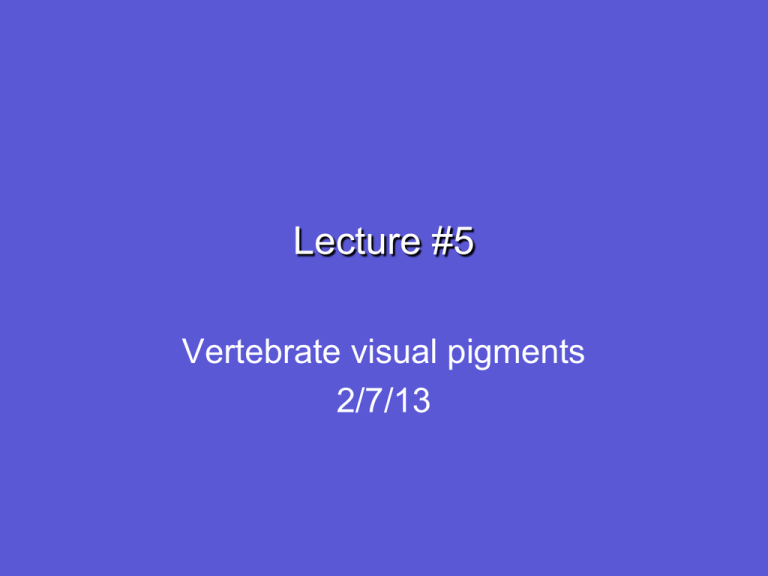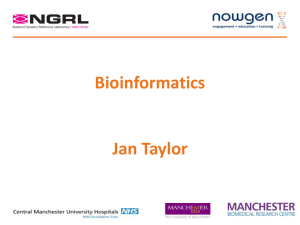Lecture 5
advertisement

Lecture #5 Vertebrate visual pigments 2/7/13 HW #3 • There are two things on the assignment page: Assign#3.pdf which has the homework problems HumanGreenRedCones.xlsx which is a spreadsheet you can use for one of the problems • I think I turned on online submissions but you don’t have to use that Today’s topics • Visual pigments and opsin genes • Opsin gene classes and diversity in vertebrates • Primates: di- and trichromacy What absorbs light in a visual pigment? 3 1 2 O 11-cis Where does it come from? Where does it come from? Your body turns -carotene into vitamin A All trans-retinOL Where does it come from? Vitamin A is converted to 11-cis retinal (visual cycle) Absorption spectrum of 11-cis retinal George Wald Nobel Prize 1967 J Biol Chem 1956 Absorption spectrum of 11-cis retinal 378 nm 11-cis retinal absorption 1.20 Relative absorption 1.00 0.80 0.60 0.40 0.20 0.00 300 350 400 450 500 550 Wavelength (nm) 600 650 700 11-cis retinal vs human visual pigments - opsin shift 1.20 Relative absorption 1.00 11-cis S M L 0.80 0.60 0.40 0.20 0.00 300 350 400 450 500 550 Wavelength (nm) 600 650 700 What is a visual pigment? • Opsin protein surrounding and bound to 11-cis retinal • Transmembrane protein Contained in the membrane • G protein coupled receptor Turns on a G protein Membrane holds the visual pigment Rods have discs Cones have continuous membrane Opsin protein is threaded through the membrane 80% of protein in outer segment is rhodopsin Rhodopsin crystal structure Visual pigment =opsin + retinal In rod, visual pigment is called rhodopsin membrane 11-cis retinal Retinal is in binding pocket of opsin protein Chang et al. 1995 11-cis bond isomerizes to form all trans Chang et al. 1995 Light causes isomerization 11-cis retinal + photon = all trans retinal 3 1 2 Light Absorbing light Excited state - stays as metaII Meta II actually is what can activate the G protein Excited state - stays as metaII Eventually the excited state decays All trans retinal dissociates, leaving opsin Opsin recombines with new Electronic energy levels of visual pigment molecule Excited state Ground state Electronic energy levels of visual pigment molecule Excited state E = hc/λ light Ground state Visual pigment absorbs light at wavelengths which can excite electrons to upper excited state Opsin interacts with retinal to make ground and excited states closer together Excited state E = hc/λ light Energy needed to excite electrons goes down Ground state Absorption is at longer wavelength Opsin interacts with retinal to make ground and excited states farther apart Excited state E = hc/λ light Energy needed to excite electrons goes up Ground state Absorption is at shorter wavelength Opsin is bound to and surrounds 11-cis retinal Chang et al. 1995 How do we get one rod and three cone visual pigments? Cones: max = 420, 535, 565 nm Rod: max = 505 nm 1.20 Relative absorption 1.00 0.80 0.60 0.40 0.20 0.00 300 350 400 450 500 550 Wavelength (nm) 600 650 700 Put a different opsin protein in each cone type Blue cone - blue opsin Green cone - green opsin Red cone - red opsin Rod - rhodopsin Webvision Blue opsin versus green opsin Human rhodopsin sequence Human Rh sequence Nathans et al 1986 Humans have 3 cone opsin genes Blue opsin - 5 exons Green and red - 6 exons Sequences for human green and red opsin genes are VERY similar HumanGreen HumanRed MAQQWSLQRLAGRHPQDSYEDSTQSSIFTYTNSNSTRGPFEGPNYHIAPRWVYHLTSVWM 60 MAQQWSLQRLAGRHPQDSYEDSTQSSIFTYTNSNSTRGPFEGPNYHIAPRWVYHLTSVWM 60 ************************************************************ HumanGreen HumanRed IFVVIASVFTNGLVLAATMKFKKLRHPLNWILVNLAVADLAETVIASTISVVNQVYGYFV 120 IFVVTASVFTNGLVLAATMKFKKLRHPLNWILVNLAVADLAETVIASTISIVNQVSGYFV 120 **** *********************************************:**** **** HumanGreen HumanRed LGHPMCVLEGYTVSLCGITGLWSLAIISWERWMVVCKPFGNVRFDAKLAIVGIAFSWIWA 180 LGHPMCVLEGYTVSLCGITGLWSLAIISWERWLVVCKPFGNVRFDAKLAIVGIAFSWIWS 180 ********************************:**************************: HumanGreen HumanRed AVWTAPPIFGWSRYWPHGLKTSCGPDVFSGSSYPGVQSYMIVLMVTCCITPLSIIVLCYL 240 AVWTAPPIFGWSRYWPHGLKTSCGPDVFSGSSYPGVQSYMIVLMVTCCIIPLAIIMLCYL 240 ************************************************* **:**:**** HumanGreen HumanRed QVWLAIRAVAKQQKESESTQKAEKEVTRMVVVMVLAFCFCWGPYAFFACFAAANPGYPFH 300 QVWLAIRAVAKQQKESESTQKAEKEVTRMVVVMIFAYCVCWGPYTFFACFAAANPGYAFH 300 *********************************::*:*.*****:************.** HumanGreen HumanRed PLMAALPAFFAKSATIYNPVIYVFMNRQFRNCILQLFGKKVDDGSELSSASKTEVSSVSS 360 PLMAALPAYFAKSATIYNPVIYVFMNRQFRNCILQLFGKKVDDGSELSSASKTEVSSVSS 360 ********:*************************************************** HumanGreen HumanRed VSPA 364 VSPA 364 **** Differ by 15 AA Why opsins are so cool • You can grow cells that express ANY opsin protein you want • You can add 11-cis retinal and purify the protein + 11-cis retinal Why opsins are so cool + 11-cis retinal LWS cone 1.0 relative absorbance • You can grow cells that express ANY opsin protein you want • You can add 11-cis retinal and purify the protein • You can measure the absorption spectrum for that visual pigment 0.8 0.6 0.4 0.2 0.0 300 400 500 wavelength, nm 600 700 You can mutate one amino acid and see how absorption peak shifts F261 F261 F261 Y261 Y261 Y261 + 11-cis retinal + 11-cis retinal F261 Y261 Changing site 261 from F to Y shifts absorption peak by +10 nm 1.2 Relative absorption 1 0.8 0.6 F261 Y261 0.4 0.2 0 300 350 400 450 500 550 Wavelength (nm) 600 650 700 Human red and green opsins A FA 535 nm 565 nm S A164S=+2 nm YT F261Y=+10 nm A269T=+14 nm These 3 AA explain most of the shift between red and green opsin genes Location of human opsin genes Exon Rhodopsin Chr 3 Blue opsin Chr 7 Red and green opsin - X chromosome Normal DNA recombination Switches genes from one chromosome to the other Leads to new gene combinations Mismatched recombination If chromosomes misalign, recombination leads to gain in genes on one chromosome and loss of genes on the other. Tandem arrays of genes Opsin gene tandem arrays on X chromosome Humans differ in how many copies they have of green gene. Only first 2 genes are expressed so it doesn’t matter if there are more green genes. They are just along for ride. Misaligned recombination Opsin genes on X chromosome If recombination happens within gene, get chimera Intermediate phenotype which results in color blindness Human red and green opsins A FA 535 nm F261Y=+10 nm A269T=+14 nm A164S=+2 nm 565 nm S YT Chimera has intermediate peak wavelength A YT 554 nm Protanope - no red cones 1% males 0.01% females max = 420, 535nm Deuteranope - no green cones 1% males 0.01% females max = 420, 565 nm Protanomoly - red pigment shifted towards green 1% male 0.01% female max = 420, 535, 550 nm Deuteranomoly - green pigment shifted towards red 5% male 0.04% female max = 420, 554, 565 nm Mutations in human opsin genes Deuteranope Protanope Protanomalous Deuteranomalous Color “blindness” Deficiency Males Females Protanopia 1% 0.01% Deuteranopia 1% 0.01% Protanomoly 1% 0.01% Deuteranomoly 5% 0.4% Total (red-green) 8% 0.5% Tritanopia 0.008% 0.008% Phylogenetics • Compare sequences and determine the relatedness of things - Calculate % similarity of DNA or AA sequences • Draw relatedness as a tree Human Human Mouse Mouse Bird Bird Vertebrates • • • • Placental mammals Marsupials Reptiles Bony fish Amphibians Birds Cartilagenous fish Jawless fish Vertebrate relationships and divergence times Human 92 71 Cow Mammals, 100 MY 41 Mouse Rat 276 Reptiles 310 Birds 360 Amphibians Tilapia 120 200 Fugu 250 Cartilagenous fish 564 500 400 Fish, 450 MY Zebrafish 528 600 Bony fish Agnatha 300 Time (Myr) 200 100 0 Kumar and Hedges 1998 Trees can also tell you about genes • What organisms have the gene? • Where did the gene come from? • What happens to the gene once it’s there? Duplicate - tandem - mRNA can be inserted Lost Line lengths are proportional to how different sequences are Human Chimp Dog Humans and chimps had a common ancestor 5-6 MYa so genes will be very similar Dogs and other mammals are about 100 MY apart so genes will be 20x more different from human as compared to human-chimp Default expectation - if gene arose early in vertebrates, all species will have a copy and gene will be related in same way as organisms Dog Gene A Opossum Gene A Chicken Gene A Frog Gene A Zebrafish Gene A Examine whether a gene exists in all organisms Dog Gene A Gained Opossum Gene A Chicken Gene A Frog Gene A Zebrafish No A Examine whether a gene exists in all organisms Mouse Platypus lost Chicken Frog Pufferfish What is happening? • Gene duplication Dog Gene A Human Gene A Chicken Gene A Frog Gene A Zebrafish Gene A1 Zebrafish Gene A2 Gene duplication Dog Human Chicken GeneA2 Frog Zebrafish Dog Human Chicken GeneA1 Frog Zebrafish Gene A Lamprey Dog GeneA2 Human Frog Chicken GeneA1 Frog Zebrafish Gene A Lamprey Gene duplication and then losses Dog Human Chicken Gene A2 Frog Zebrafish Dog Human Chicken Gene A1 Frog Zebrafish Lamprey Opsin genes • Opsin genes can duplicate Tandem duplication Chromosomal duplication Whole genome duplication • Opsin genes can be lost • Can reinsert from mRNA No introns Opsin genes from: • • • • • • Lamprey (jawless vertebrate) Zebrafish Anole (reptile) Chicken (bird) Mouse Human SWS2 RH2 RH1 SWS1 LWS What does this tree tell us? Conclusions from opsin tree #1 • 5 opsin classes arose very early in vertebrates SWS1 - very short wavelength sensitive SWS2 - short wavelength sensitive RH2 - like rhopopsin but in cones LWS - long wavelength sensitive RH1 - rhodopsin cones rods Range of cone visual pigment λmax SWS2 SWS1 LWS RH2 Conclusion #2 • Rod opsins evolved from cone opsins RH1 RH2 SWS2 SWS1 LWS SWS2 RH2 RH1 SWS1 LWS Mammalian genes Conclusion #3 • Mammals lost two of the opsin classes Mammals have LWS, SWS1 and RH1 Only 2 cone opsins (dichromat) Dogs, cats, mice, rats, horses, goats, pigs … • Mammals went through “nocturnal period” during reign of dinosaurs “Rugrats” “Spike’s view” Spike’s view? SWS2 RH2 RH1 SWS1 LWS Human genes Conclusion #4 • Primates had a duplication of the LWS gene • Went from dichromatic to trichromatic Human green and red opsins are part of LWS class = M/LWS max = 535, 565 nm M/LWS opsin duplication on X chromosome Rhodopsin Chr 3 Blue opsin Chr 7 Red and green opsin - X chromosome X New world vs Old world primates X Why trichromacy? Why two ‘LWS’ cone types? Dichromacy with a single LWS and an SWS1 cone type gives no red-green discrimination. Jim Bowmaker Trichromacy with two ‘LWS’ cone types and an SWS1 cone gives red-green discrimination. Ripe fruit and young, more reddish leaves can be detected against the dappled green foliage. Jim Bowmaker









